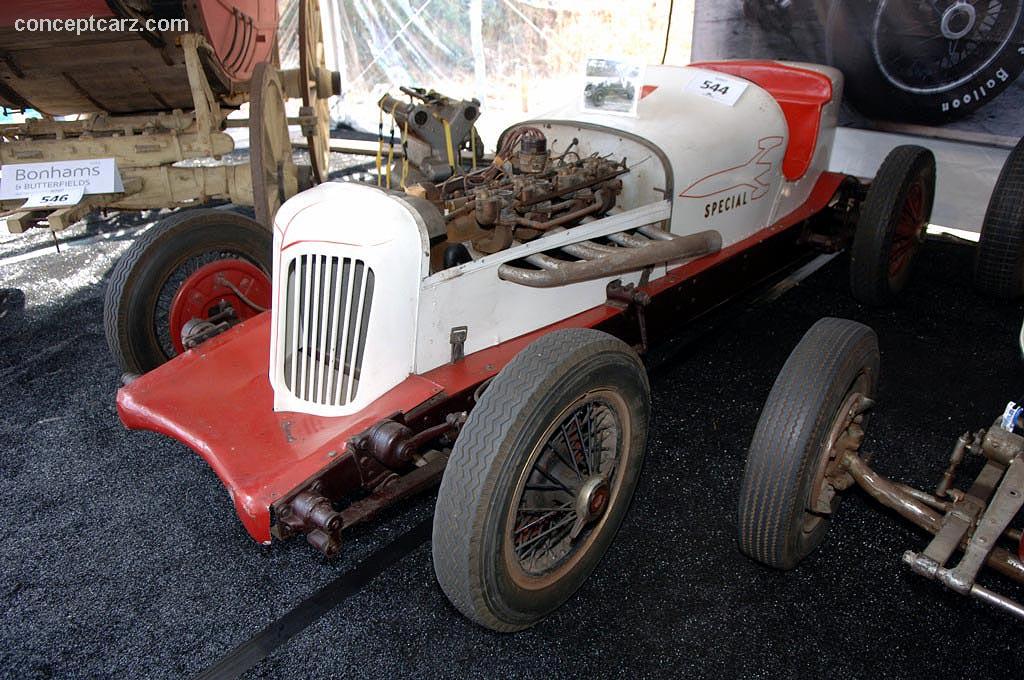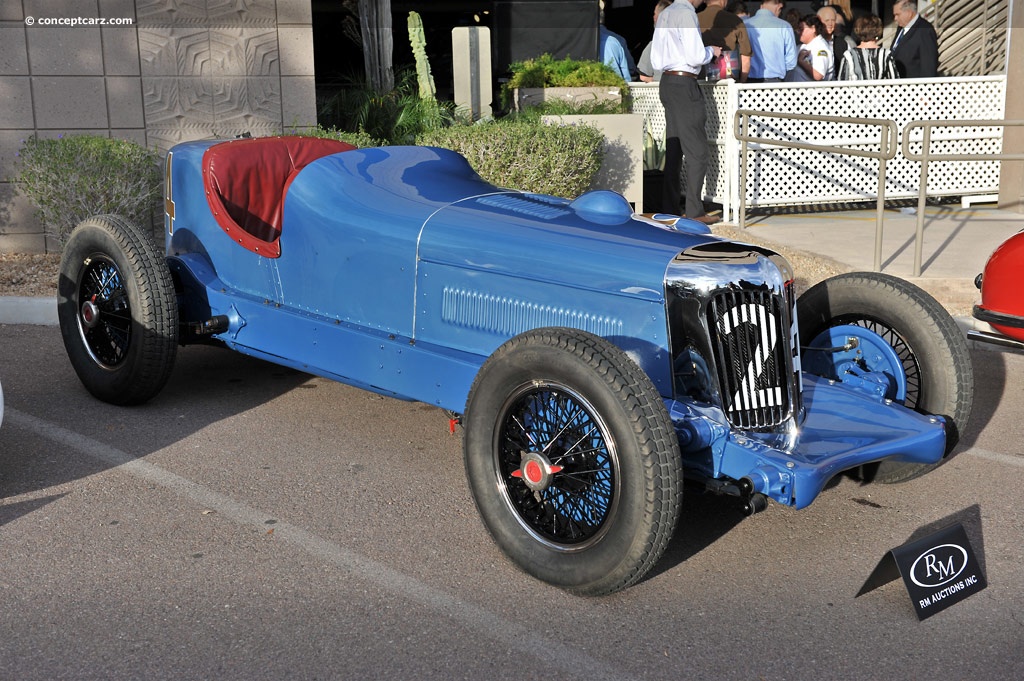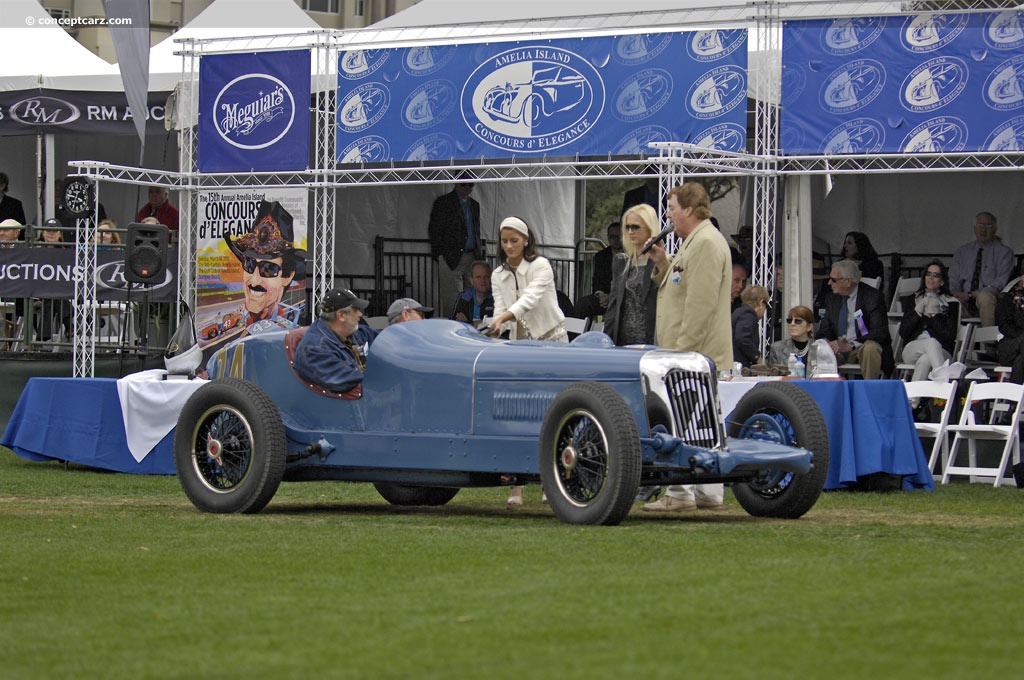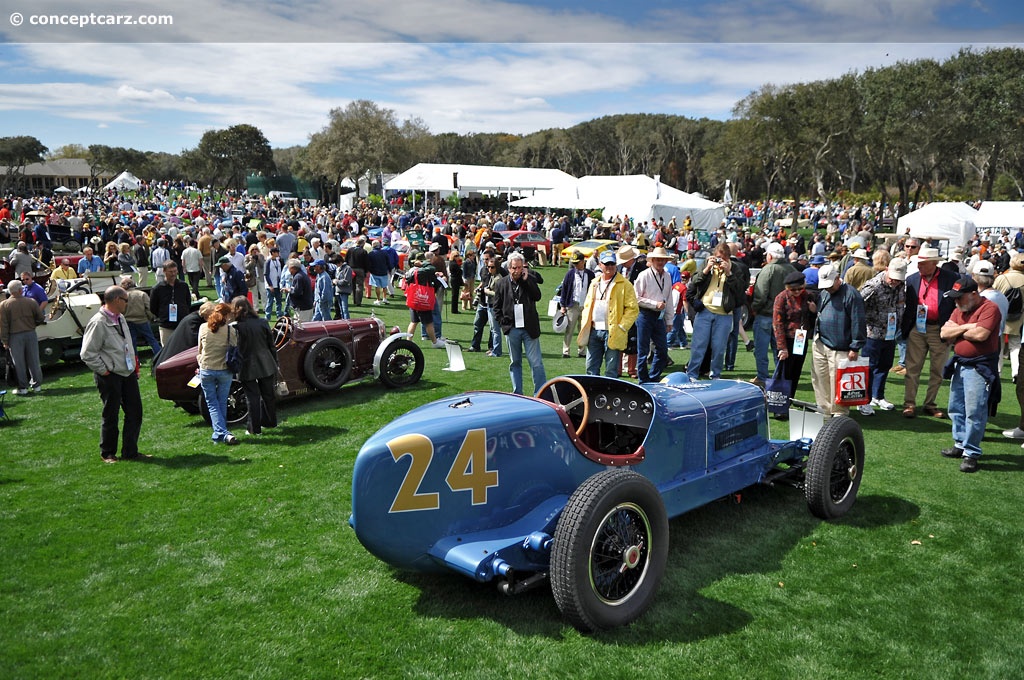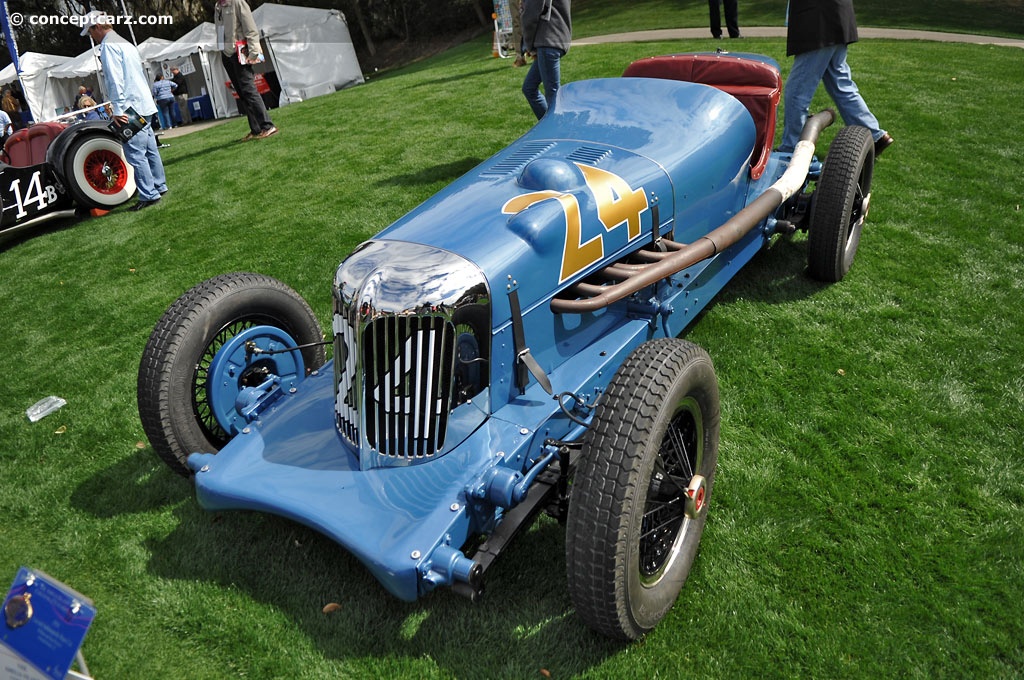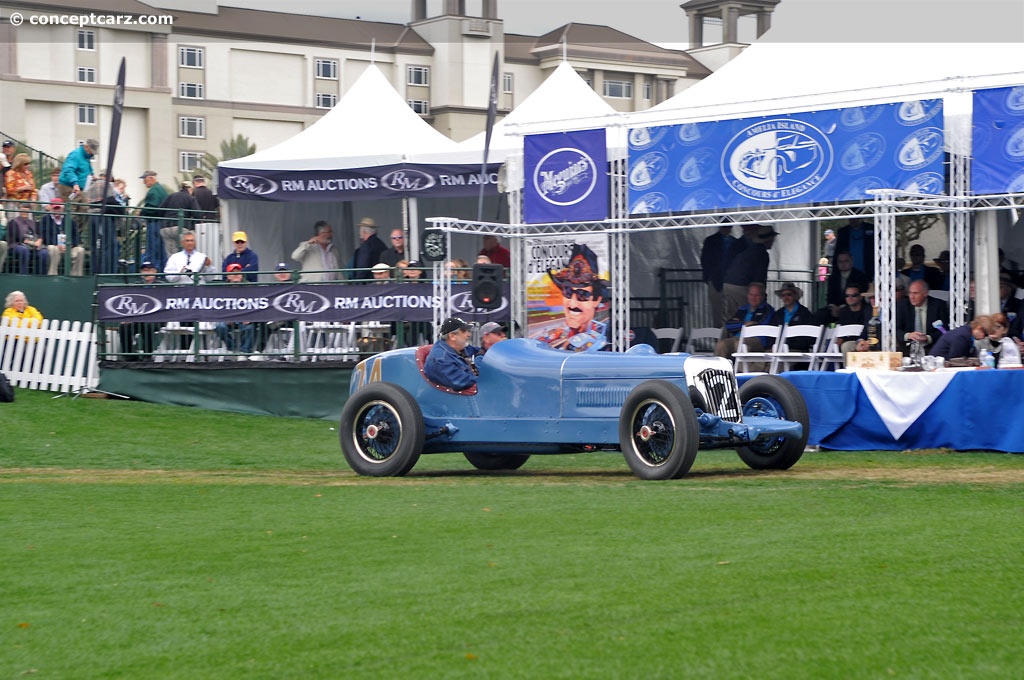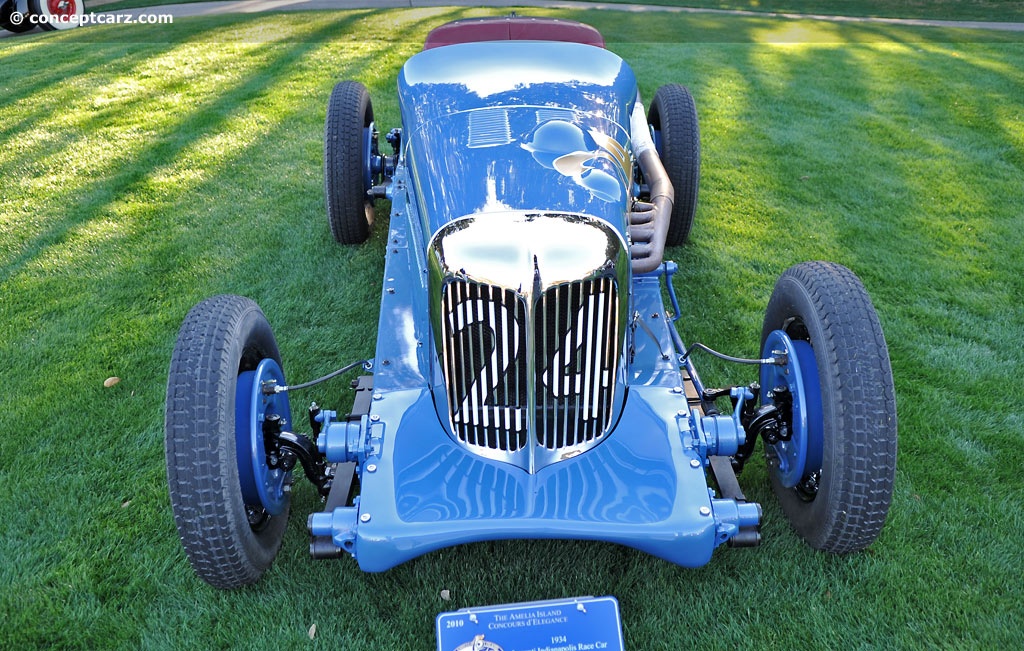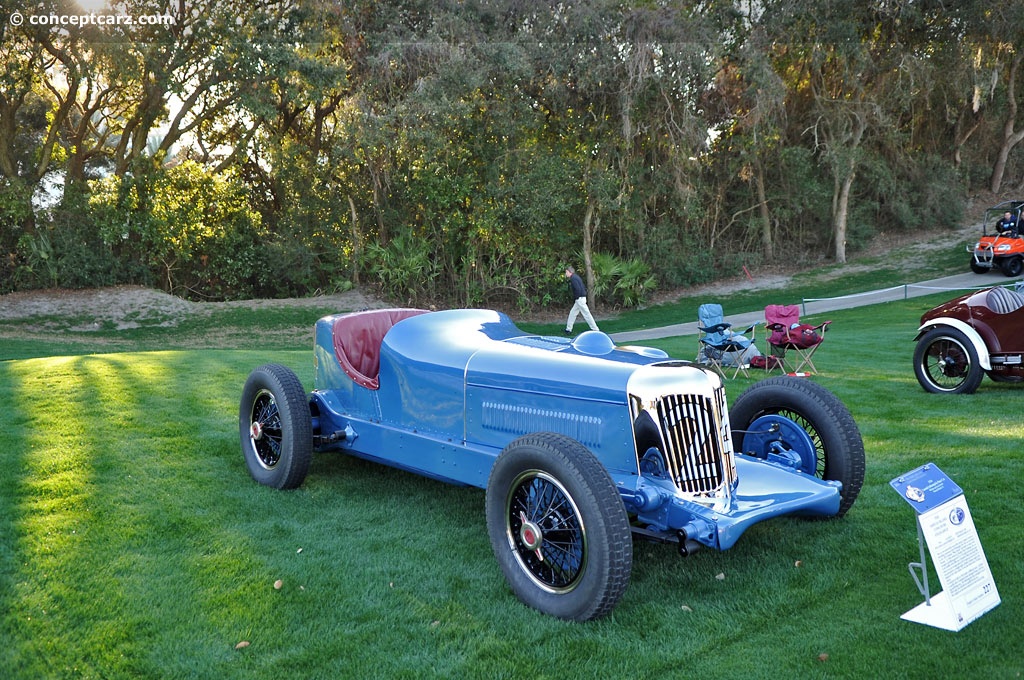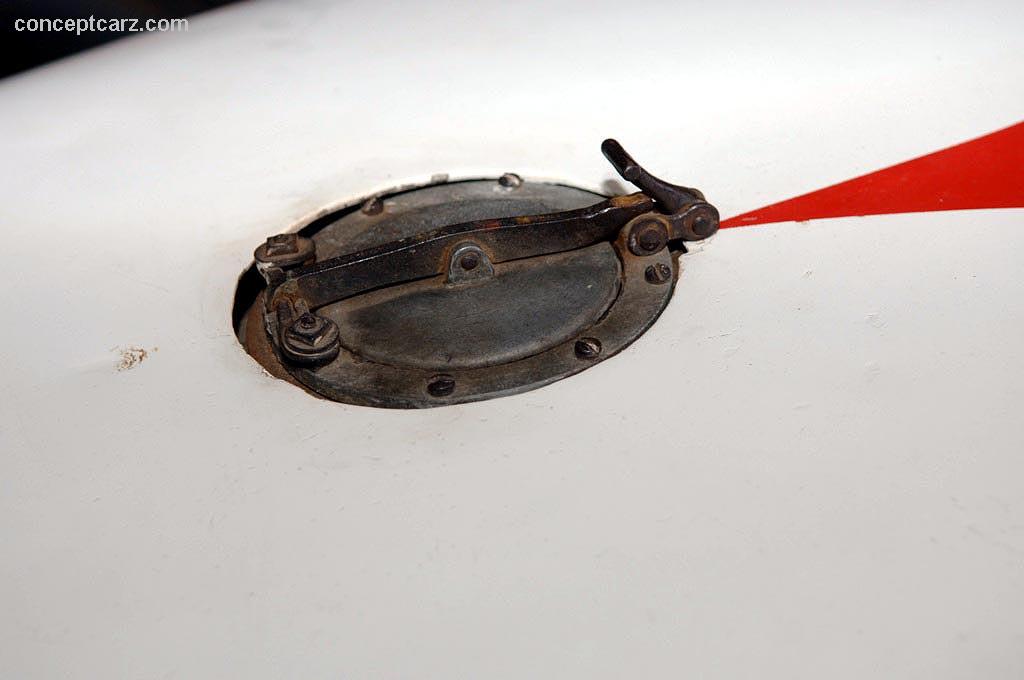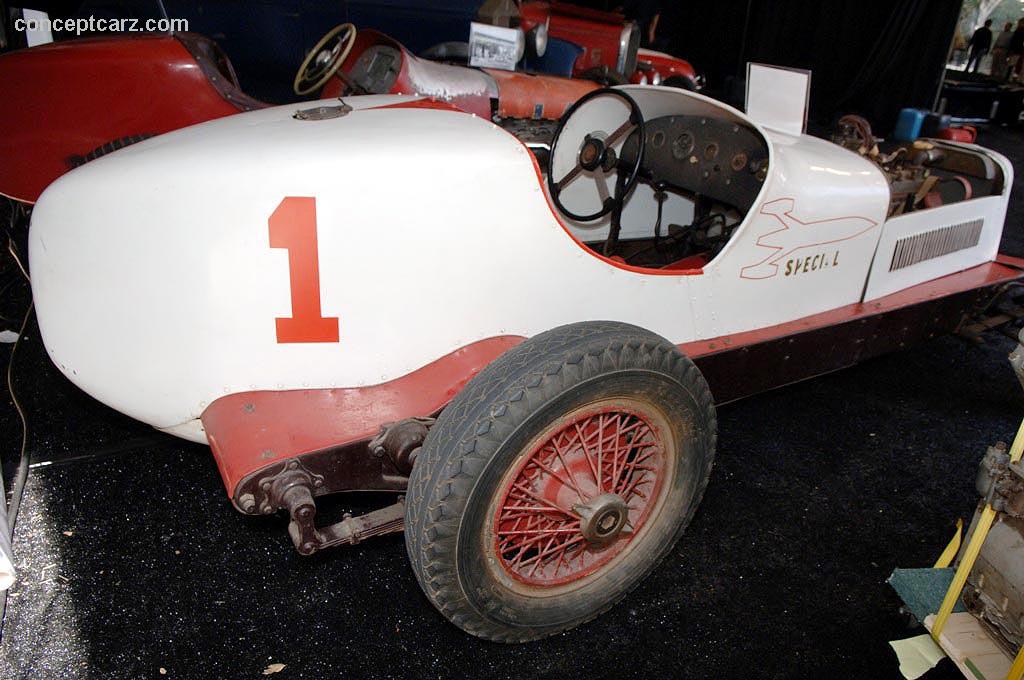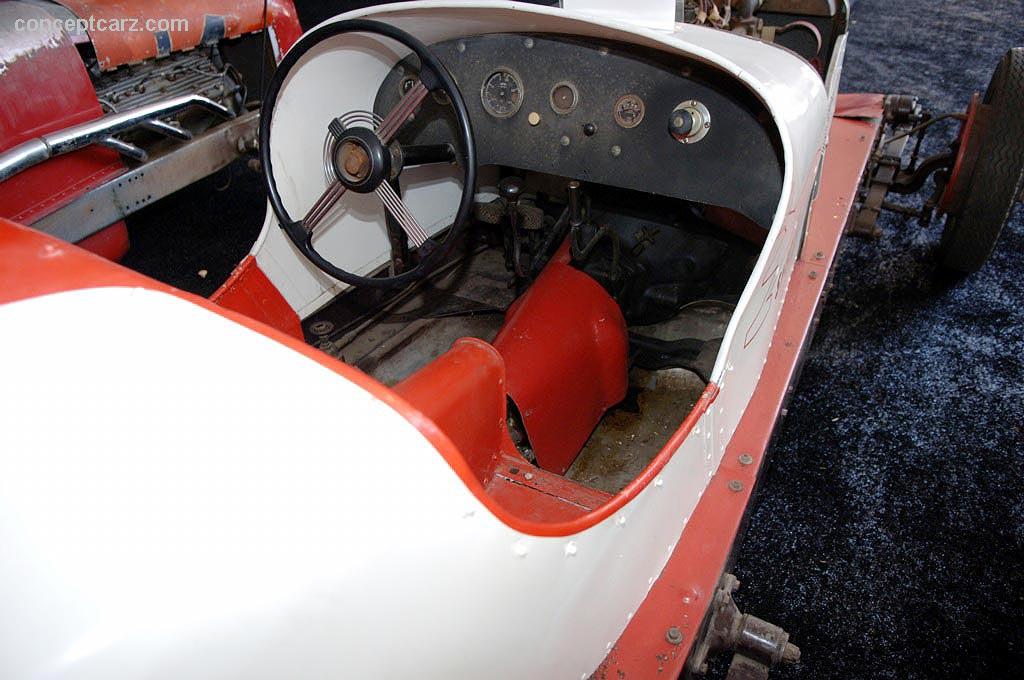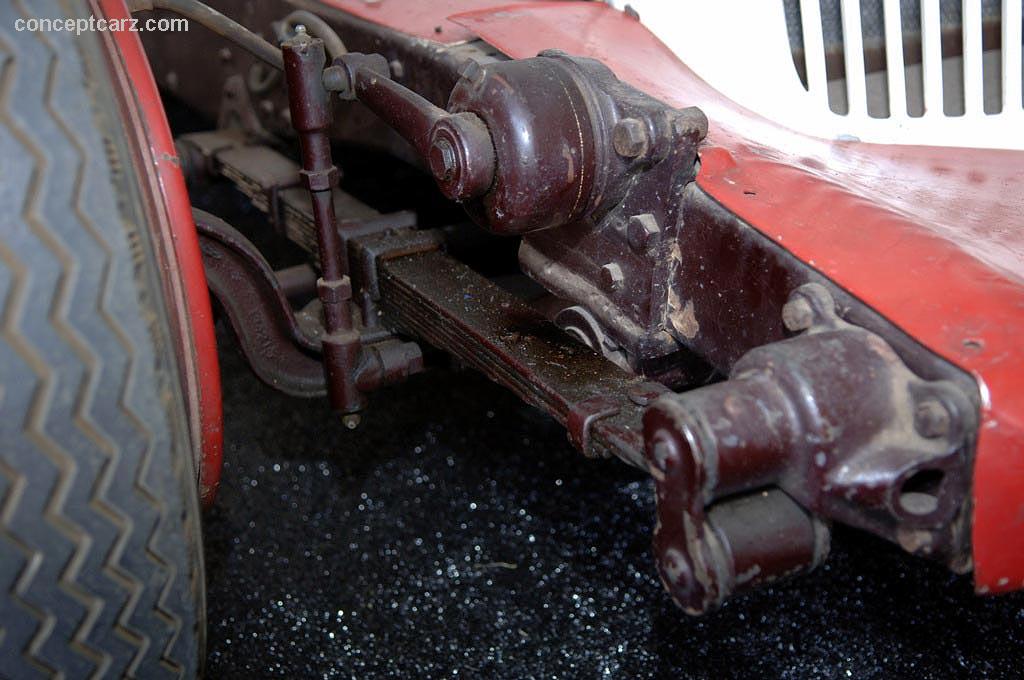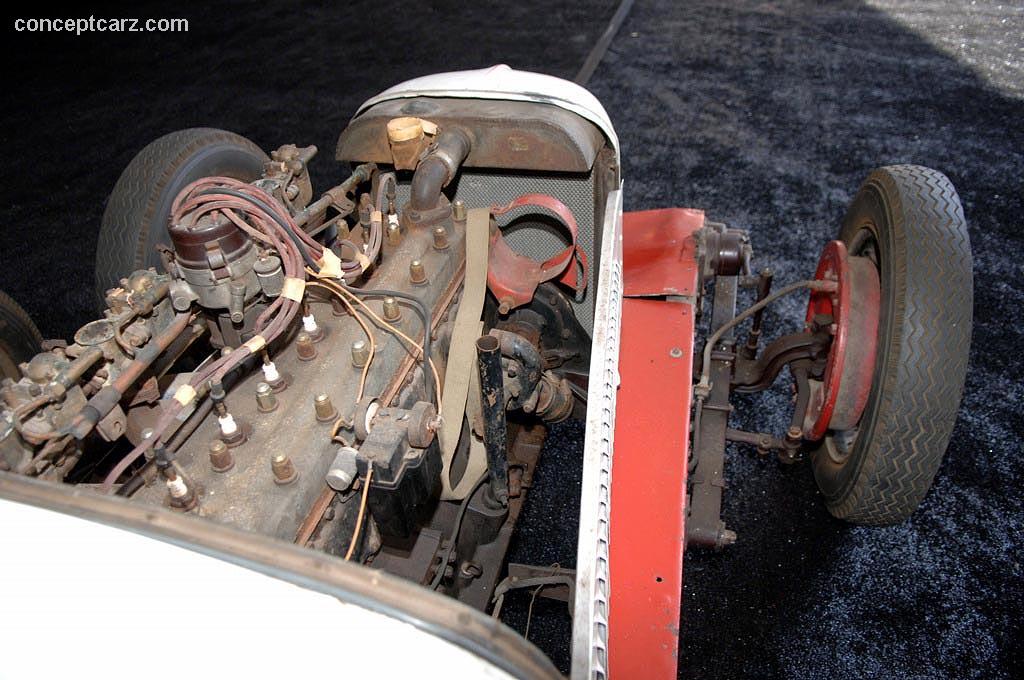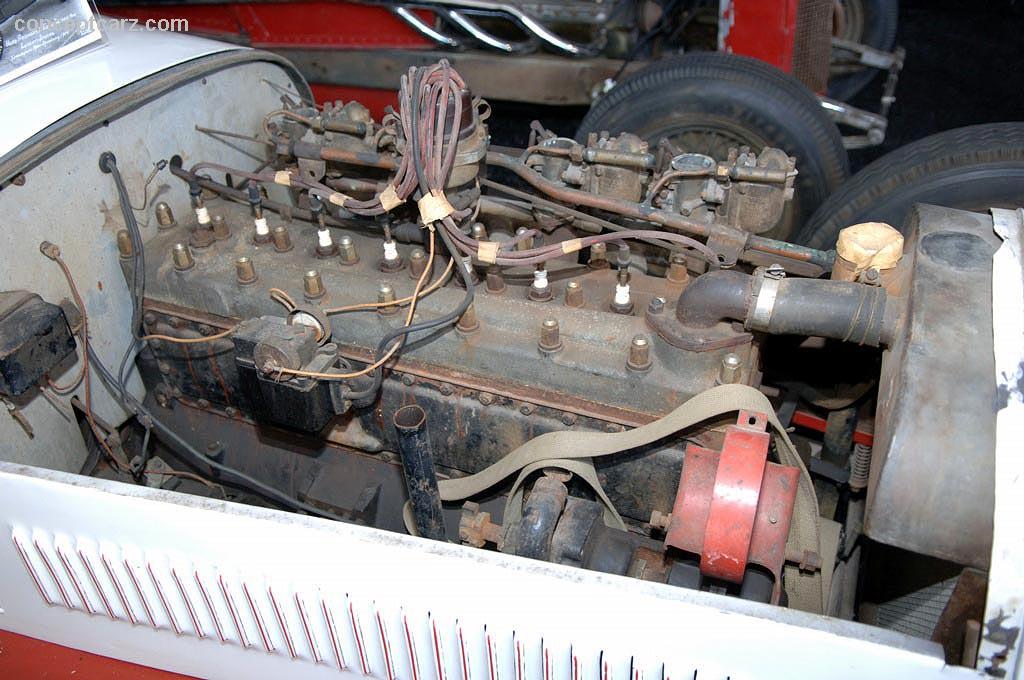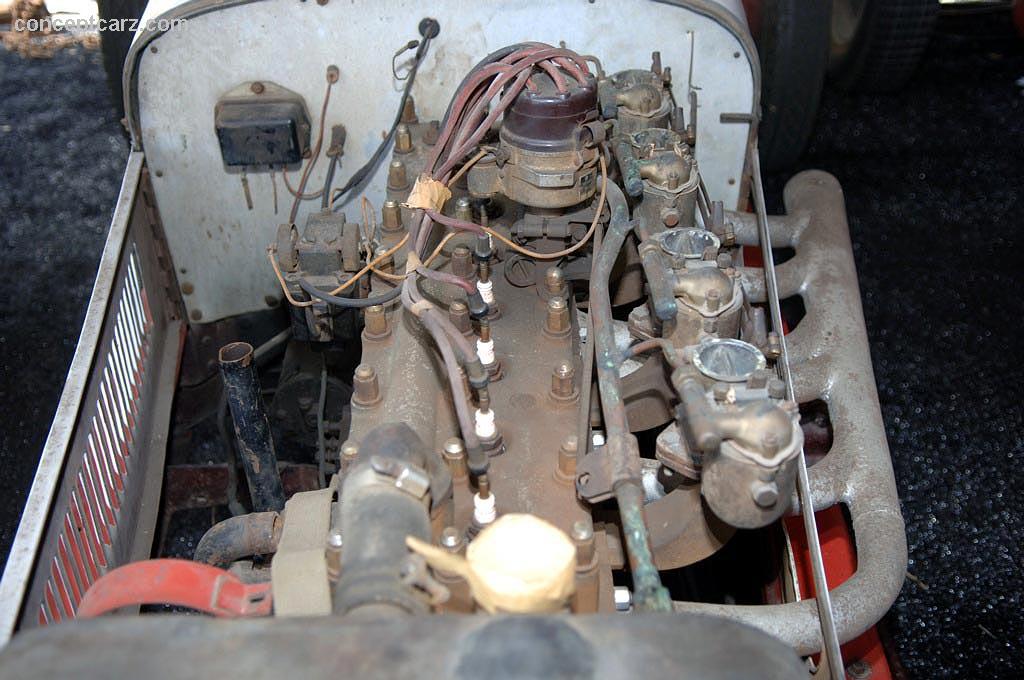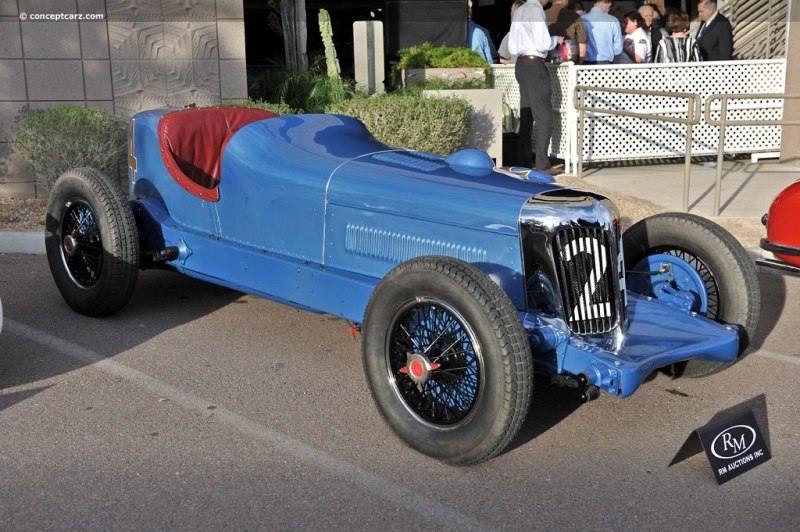Image credit: © conceptcarz.com (Reproduction Or reuse prohibited).
This car was named after one of the owners, Angelo Lucenti, a plumbing contractor from Pittsburgh, PA. The car was based on the 1932 Graham 'Blue Streak' and built to super stock formula. In 1934, driven by Rookie Herb Andinger, the car averaged a qualifying speed of 111.722 mph and secured a spot in the middle of the fifth row. It finished 10th in the Indy 500, where it ran an average speed of 95.9 mph and won $1,425. It was powered by a straight-eight-cylinder Graham engine that displaced 265 cubic inches. It was also fitted with a Graham chassis.
It returned to Indy in 1935 under a different name. It failed to qualify after sustaining minor damage hitting a wall during qualifying runs. The following day they managed a run of 106.6 mph but still did not qualify for the race.
This original car has been restored as it last raced at Indy.
It returned to Indy in 1935 under a different name. It failed to qualify after sustaining minor damage hitting a wall during qualifying runs. The following day they managed a run of 106.6 mph but still did not qualify for the race.
This original car has been restored as it last raced at Indy.
The Great Depression affected industries on a global scale. The automobile industry was not shielded from this catastrophe; many prominent and well-established businesses were forced to close their doors forever. The racing industry was the same; people were unwilling or unable to participate as either an entrant or a spectator as they had done prior to The Great Depression. To re-stimulate racing, Indy created the 'Junk Formula,' which was aimed at attracting low-cost racers and home-grown specials to participate. The rules were more relaxed, and the response was spectacular. In 1933, a total of 42 cars lined up for top honors. This caused other problems, or at least fueled problems that were already existent, mainly safety concerns. From 1931 through 1935, there were 15 fatalities. The problems were many, such as faster racing speeds, track conditions, and an increase in drivers. To help alleviate this problem, some of the bricks in parts of the track were removed and the area was repaved with tarmac.
The supercharged 91 cubic-inch Millers and Duesenbergs of the 1920s had dominated the Indy racing scene. They were powerful, advanced and well-refined. To bring competition back to Indy, and to reduce the speeds, the Junk Formula was established.
During the early 1930s, Angelo Lucenti, Roy W. Painter, and John C. Saunders created Lupasa. The name was formed from the surnames of these individuals, LUcenti, PAinter, and SAunders. The group was located in Pittsburgh, Pennsylvania, and the racer they created was formed mostly from spare parts. Under the bonnet was a straight-eight-cylinder Graham engine that displaced 265 cubic inches. To boost power even further, the engine was fitted with a high-lift cam and larger valves. Since the Junk Formula class did not allow superchargers, and the Graham came equipped with a centrifugal blower, it was removed and replaced with four Winfield Model SR carburetors.
The car was brought to Indianapolis for the 1932 500 race, where it failed to qualify. The car had been driven by Painter and his riding mechanic, Eddie Shearn. It was later raced at Syracuse, New York, with Bryan Saulspaugh at the wheel, and managed a 21st in qualifying. This was too slow to make the grid.
In 1934, Lucenti, a plumbing contractor from Pittsburgh, brought the car back to Indy using his own name to identify the vehicle. It was driven by Ardinger who was accompanied by his riding mechanic, Shearn, drove the car to a 111.722 mph qualifying speed and managed to secure a location in the middle of the fifth row. Ardinger drove most the race, relinquishing the reigns on lap number 92 to Danny Day, who drove the car the remained of the race. At the conclusion of the race, the Lucenti Special had managed a tenth-place finish and had averaged 95.9 mph. The car had managed to finish the race and beat a slew of other faster competitors.
The Lucenti's next race was at Springfield, Illinois where it qualified 11th and finished 8th. It was brought to Syracuse, where it qualified 9th and ran in eight-place until a bearing failed on lap number 51, and it was forced to retire prematurely.
For the 1935 season, Painter brought the car back to Indy under the name 'Frigenor Special.' It was driven by Herschell McKee who spun the car during qualifying and ran it into a wall. The car sustained minor damage. Painter drove the car on the following day, and managed a 106.6 mph effort, but did not qualify for the race.
It may have been used in minor races for the next few years throughout Western Pennsylvania and Ohio before it was abandoned in an orphanage yard. The car was later sold to its next owner, who had kept it for over fifty years. The car was restored to its original glory, and a rocket-ship design was painted on its side. The maroon-painted body was replaced with white. Other non-original features of this car are its missing tailpipes and upholstery. The rest of the car, from its aluminum body, wheels, transmission, and engine, are all original.
This car was offered for sale at the 2006 Bonhams & Butterfields auction held at the Quail Lodge in Carmel, California, where it was estimated to sell between $225,000 - $300,000. The lot was sold for $216,000, selling just below the vehicle's estimated value. Still, a fine price for a highly-original car with a racing history that includes a tenth-place finish at Indy.By Daniel Vaughan | Jan 2011
The supercharged 91 cubic-inch Millers and Duesenbergs of the 1920s had dominated the Indy racing scene. They were powerful, advanced and well-refined. To bring competition back to Indy, and to reduce the speeds, the Junk Formula was established.
During the early 1930s, Angelo Lucenti, Roy W. Painter, and John C. Saunders created Lupasa. The name was formed from the surnames of these individuals, LUcenti, PAinter, and SAunders. The group was located in Pittsburgh, Pennsylvania, and the racer they created was formed mostly from spare parts. Under the bonnet was a straight-eight-cylinder Graham engine that displaced 265 cubic inches. To boost power even further, the engine was fitted with a high-lift cam and larger valves. Since the Junk Formula class did not allow superchargers, and the Graham came equipped with a centrifugal blower, it was removed and replaced with four Winfield Model SR carburetors.
The car was brought to Indianapolis for the 1932 500 race, where it failed to qualify. The car had been driven by Painter and his riding mechanic, Eddie Shearn. It was later raced at Syracuse, New York, with Bryan Saulspaugh at the wheel, and managed a 21st in qualifying. This was too slow to make the grid.
In 1934, Lucenti, a plumbing contractor from Pittsburgh, brought the car back to Indy using his own name to identify the vehicle. It was driven by Ardinger who was accompanied by his riding mechanic, Shearn, drove the car to a 111.722 mph qualifying speed and managed to secure a location in the middle of the fifth row. Ardinger drove most the race, relinquishing the reigns on lap number 92 to Danny Day, who drove the car the remained of the race. At the conclusion of the race, the Lucenti Special had managed a tenth-place finish and had averaged 95.9 mph. The car had managed to finish the race and beat a slew of other faster competitors.
The Lucenti's next race was at Springfield, Illinois where it qualified 11th and finished 8th. It was brought to Syracuse, where it qualified 9th and ran in eight-place until a bearing failed on lap number 51, and it was forced to retire prematurely.
For the 1935 season, Painter brought the car back to Indy under the name 'Frigenor Special.' It was driven by Herschell McKee who spun the car during qualifying and ran it into a wall. The car sustained minor damage. Painter drove the car on the following day, and managed a 106.6 mph effort, but did not qualify for the race.
It may have been used in minor races for the next few years throughout Western Pennsylvania and Ohio before it was abandoned in an orphanage yard. The car was later sold to its next owner, who had kept it for over fifty years. The car was restored to its original glory, and a rocket-ship design was painted on its side. The maroon-painted body was replaced with white. Other non-original features of this car are its missing tailpipes and upholstery. The rest of the car, from its aluminum body, wheels, transmission, and engine, are all original.
This car was offered for sale at the 2006 Bonhams & Butterfields auction held at the Quail Lodge in Carmel, California, where it was estimated to sell between $225,000 - $300,000. The lot was sold for $216,000, selling just below the vehicle's estimated value. Still, a fine price for a highly-original car with a racing history that includes a tenth-place finish at Indy.By Daniel Vaughan | Jan 2011
Auto racing has always had a couple of nagging questions it has had to address: 'How can we increase competition? And, how can the cars be made simpler and less expensive?' These questions existed from the very first days of auto racing and are a big emphasis of every series in existence today.
Back in 1930, the apparent answer to those questions came to be what was not-so-loving referred to as the 'Junk Formula.'
In 1928 Indianapolis Motor Speedway invited engineers from the auto industry to a meeting to discuss attracting a new class of competitors and finding ways to involve the car industry in technical innovations. Throughout the 1920s, the 500-mile race had come down to a battle literally between just two car types, the Duesenbergs and the Miller chassis. Because only a couple of purpose-built cars were winning the big race year after year, many other car manufacturers were turned away from racing. As with any motor racing series, the presence of many car manufacturers keeps the series healthy and wealthy because it helps to keep costs down. Purpose-built race cars are very expensive because they are few in number and replacement parts are likewise few in number.
The meeting called by the Indianapolis Motor Speedway was meant to address this very real challenge and to try and increase interest and competition. What was decided was that there would be a certain number of regulations imposed. As the new regulations favored production-based parts and components, the series was derogatorily called the 'Junk Formula' by many.
The new regulations were not bad in everybody's eyes. Some saw it as their opportunity to get involved in motor racing. Among those who saw this as their opportunity were three businessmen from Pittsburgh. Angelo Lucenti, Roy Painter, and John Saunders started Lupasa.
The epitome of what the new regulations were intended to do, the Pittsburgh businessmen started out with a straight-eight engine from a Graham Blue Streak, and then, built a car up around it from more available production parts. When the car was finished being put together, Lupasa had a 265 cubic inch L-head inline eight-cylinder engine car with a three-speed manual transmission and four-wheel hydraulic drum brakes. Suspension for the car consisted of a solid front axle and live rear axle, both with semi-elliptic leaf springs. As could be expected, the body was narrow but wide enough for a driver and a mechanic.
While the new regulations made it possible for just about anybody to go racing, Lupasa proved that not just anyone could go racing. In 1932, the businessmen entered their car for the Indianapolis 500-mile race. Painter would be the car's driver and Eddie Shearn riding along as a mechanic. Painter ended up failing to qualify for the race.
The car proved too slow once again when it was entered in a race in Syracuse, New York. Not much was heard from the team after 1932. Then, in 1934, the car was again entered in the Indy 500, but under Lucenti's own name. Herb Ardinger managed to get the car in the race this time with a speed of 111.722 mph. This placed Ardinger on the 5th row of the grid. During the race, Danny Day took over behind the wheel on lap 92. Day ended up the race in 10th and averaged a little over 95 mph. The car achieved its best result ever for Lucenti at Springfield, Illinois when it finished 8th in a race during that year.
Painter took the car back to Indianapolis the following year and tried to enter it in the race. The car spun during qualifying, however, and lightly touched the wall. The damage was light enough that Painter tried to qualify it again the following day, but was unable to achieve a speed fast enough to make the field.
The fate handed to the Lupasa chassis would have made those who held the new regulations in such low esteem incredibly happy. After possibly being raced a few more times, the car was donated to an orphanage and basically became a play-toy.
When the car was discovered a few years later, it was found to be in remarkable shape. All of the car's major original components were still on the car. The car was repainted and kept for over 50 years. In 2006, the Lucenti Special was sold.
Upon being purchased at auction, the car was taken and restored to the way it was when it was entered in the 1934 Indianapolis 500. The restoration work ended up garnering a class win at Amelia Island just this past year. This same class-winning car was made available at this year's auction, and was expected to earn more money than it ever had while racing.
Due to 'Junk Formula' survivors being incredibly few in number, and because of the condition of this example, Lucenti's Special is more commanding of attention and worthy of awards than when it first came to be seventy years ago. Truly this 'Junk' has become another's treasure.
'The Junk Formula', (http://oilpressure.wordpress.com/2010/02/10/the-junk-formula/). OilPressure: Speed is Life. http://oilpressure.wordpress.com/2010/02/10/the-junk-formula/. Retrieved 12 January 2011.
'Buy: View Lots (Lot 255: 1932 Lucenti Indianapolis Special)', (http://www.rmauctions.com/FeatureCars.cfm?SaleCode=AZ11&CarID=r201&fc=0). RM Auctions Arizona. http://www.rmauctions.com/FeatureCars.cfm?SaleCode=AZ11&CarID=r201&fc=0. Retrieved 12 January 2011.By Jeremy McMullen
Back in 1930, the apparent answer to those questions came to be what was not-so-loving referred to as the 'Junk Formula.'
In 1928 Indianapolis Motor Speedway invited engineers from the auto industry to a meeting to discuss attracting a new class of competitors and finding ways to involve the car industry in technical innovations. Throughout the 1920s, the 500-mile race had come down to a battle literally between just two car types, the Duesenbergs and the Miller chassis. Because only a couple of purpose-built cars were winning the big race year after year, many other car manufacturers were turned away from racing. As with any motor racing series, the presence of many car manufacturers keeps the series healthy and wealthy because it helps to keep costs down. Purpose-built race cars are very expensive because they are few in number and replacement parts are likewise few in number.
The meeting called by the Indianapolis Motor Speedway was meant to address this very real challenge and to try and increase interest and competition. What was decided was that there would be a certain number of regulations imposed. As the new regulations favored production-based parts and components, the series was derogatorily called the 'Junk Formula' by many.
The new regulations were not bad in everybody's eyes. Some saw it as their opportunity to get involved in motor racing. Among those who saw this as their opportunity were three businessmen from Pittsburgh. Angelo Lucenti, Roy Painter, and John Saunders started Lupasa.
The epitome of what the new regulations were intended to do, the Pittsburgh businessmen started out with a straight-eight engine from a Graham Blue Streak, and then, built a car up around it from more available production parts. When the car was finished being put together, Lupasa had a 265 cubic inch L-head inline eight-cylinder engine car with a three-speed manual transmission and four-wheel hydraulic drum brakes. Suspension for the car consisted of a solid front axle and live rear axle, both with semi-elliptic leaf springs. As could be expected, the body was narrow but wide enough for a driver and a mechanic.
While the new regulations made it possible for just about anybody to go racing, Lupasa proved that not just anyone could go racing. In 1932, the businessmen entered their car for the Indianapolis 500-mile race. Painter would be the car's driver and Eddie Shearn riding along as a mechanic. Painter ended up failing to qualify for the race.
The car proved too slow once again when it was entered in a race in Syracuse, New York. Not much was heard from the team after 1932. Then, in 1934, the car was again entered in the Indy 500, but under Lucenti's own name. Herb Ardinger managed to get the car in the race this time with a speed of 111.722 mph. This placed Ardinger on the 5th row of the grid. During the race, Danny Day took over behind the wheel on lap 92. Day ended up the race in 10th and averaged a little over 95 mph. The car achieved its best result ever for Lucenti at Springfield, Illinois when it finished 8th in a race during that year.
Painter took the car back to Indianapolis the following year and tried to enter it in the race. The car spun during qualifying, however, and lightly touched the wall. The damage was light enough that Painter tried to qualify it again the following day, but was unable to achieve a speed fast enough to make the field.
The fate handed to the Lupasa chassis would have made those who held the new regulations in such low esteem incredibly happy. After possibly being raced a few more times, the car was donated to an orphanage and basically became a play-toy.
When the car was discovered a few years later, it was found to be in remarkable shape. All of the car's major original components were still on the car. The car was repainted and kept for over 50 years. In 2006, the Lucenti Special was sold.
Upon being purchased at auction, the car was taken and restored to the way it was when it was entered in the 1934 Indianapolis 500. The restoration work ended up garnering a class win at Amelia Island just this past year. This same class-winning car was made available at this year's auction, and was expected to earn more money than it ever had while racing.
Due to 'Junk Formula' survivors being incredibly few in number, and because of the condition of this example, Lucenti's Special is more commanding of attention and worthy of awards than when it first came to be seventy years ago. Truly this 'Junk' has become another's treasure.
'The Junk Formula', (http://oilpressure.wordpress.com/2010/02/10/the-junk-formula/). OilPressure: Speed is Life. http://oilpressure.wordpress.com/2010/02/10/the-junk-formula/. Retrieved 12 January 2011.
'Buy: View Lots (Lot 255: 1932 Lucenti Indianapolis Special)', (http://www.rmauctions.com/FeatureCars.cfm?SaleCode=AZ11&CarID=r201&fc=0). RM Auctions Arizona. http://www.rmauctions.com/FeatureCars.cfm?SaleCode=AZ11&CarID=r201&fc=0. Retrieved 12 January 2011.By Jeremy McMullen
2011 Automobiles of Arizona by RM Auctions
Pre-Auction Estimates :
USD $175,000-USD $275,000
Sale Price :
USD $187,000
2010 Bonhams - Quail Lodge
Pre-Auction Estimates :
USD $300,000-USD $400,000
Lot was not sold
2006 Bonhams & Butterfields at The Quail Lodge, Resort & Golf Club
Pre-Auction Estimates :
USD $225,000-USD $300,000
Sale Price :
USD $216,000
Recent Sales of the Lucenti Special
(Data based on Model Year 1932 sales)
| 1932 Lucenti Indianapolis Special Sold for USD$187,000 2011 Automobiles of Arizona by RM Auctions |   |
| 1932 Lucenti Special Sold for USD$216,000 2006 Bonhams & Butterfields at The Quail Lodge, Resort & Golf Club |   |
Lucenti Specials That Failed To Sell At Auction
1932 Lucenti Special's that have appeared at auction but did not sell.
| Vehicle | Chassis | Event | High Bid | Est. Low | Est. High |
|---|---|---|---|---|---|
| 1932 Lucenti Special Two-Man Indianapolis Race Car | 2010 Bonhams Quail Lodge | $300,000 | $400,000 |
Vehicles With Comparable Market Values
Similar sales to the $201,500 range.
| 2023 FORD SHELBY SUPER SNAKE SPEEDSTER Chassis#:1FATP8FF9P5105982 Sold for $203,500 2024 Barrett-Jackson : Palm Beach | |
| 2017 FERRARI 488 SPIDER Chassis#:ZFF80AMA5H0226981 Sold for $203,500 2024 Barrett-Jackson : Palm Beach | |
| 1963 Chevrolet Corvette Split Window Coupe Chassis#:30837s114963 Sold for $203,500 2024 Mecum : Glendale | |
| 2002 BMW Z8 Chassis#:WBAEJ13462AH61832 Sold for $201,600 2024 Broad Arrow Auctions : Amelia |  |
| 1967 Chevrolet Corvette 427/435HP Convertible Chassis#:194677S119348 Sold for $201,600 2024 Bonhams : Amelia Island Auction | |
| 1961 Jaguar E-Type Series I 3.8 Roadster Chassis#:875256 Sold for $199,739 2024 RM Sothebys : Paris | |
| 1967 Porsche 911 S 'Soft-Window' Targa Chassis#:500691 Sold for $199,739 2024 RM Sothebys : Paris | |
| 1958 CHEVROLET CORVETTE CUSTOM CONVERTIBLE Chassis#:J58S107242 Sold for $203,500 2024 Barrett-Jackson : Scottsdale AZ | |
| 1971 CHEVROLET K5 BLAZER CUSTOM SUV Chassis#:KE181S678691 Sold for $203,500 2024 Barrett-Jackson : Scottsdale AZ | |
| 1996 PORSCHE 911 CARRERA 4 Chassis#:WP0AA2998TS321730 Sold for $203,500 2024 Barrett-Jackson : Scottsdale AZ | |
| 2023 NISSAN GT-R NISMO Chassis#:JN1AR5DF5PM200111 Sold for $203,500 2024 Barrett-Jackson : Scottsdale AZ | |
| 2022 MASERATI MC20 Chassis#:ZAM24BXA6N0380746 Sold for $203,500 2024 Barrett-Jackson : Scottsdale AZ | |
| 1927 FORD CUSTOM ROADSTER Chassis#:WA98228782 Sold for $203,500 2024 Barrett-Jackson : Scottsdale AZ | |
| 1972 CHEVROLET K5 BLAZER CUSTOM SUV Chassis#:CKE182F141682 Sold for $203,500 2024 Barrett-Jackson : Scottsdale AZ | |
| 1971 CHEVROLET BLAZER CUSTOM SUV Chassis#:KE181S628216 Sold for $200,200 2024 Barrett-Jackson : Scottsdale AZ | |
| 1939 LINCOLN ZEPHYR CUSTOM CONVERTIBLE Chassis#:OK1024229376 Sold for $203,500 2024 Barrett-Jackson : Scottsdale AZ | |
| 2019 Chevrolet Corvette ZR1 Convertible Chassis#:1g1y53d93k5800899 Sold for $203,500 2024 Mecum : Kissimmee | |
| 1969 Chevrolet COPO Camaro Chassis#:124379n640518 Sold for $203,500 2024 Mecum : Kissimmee | |
| 1970 Plymouth Hemi Road Runner Coupe Chassis#:rm21r0g219945 Sold for $203,500 2024 Mecum : Kissimmee | |
| 2019 Chevrolet Corvette ZR1 Convertible Chassis#:1g1y53d95k5800936 Sold for $203,500 2024 Mecum : Kissimmee |
1932 Lucenti Special
• Additional valuation insight and sales data• History
• Specifications
• Image gallery
